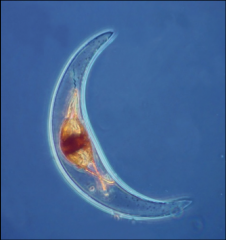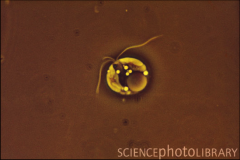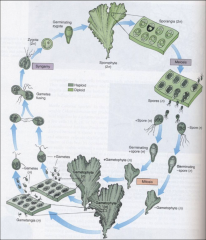![]()
![]()
![]()
Use LEFT and RIGHT arrow keys to navigate between flashcards;
Use UP and DOWN arrow keys to flip the card;
H to show hint;
A reads text to speech;
55 Cards in this Set
- Front
- Back
|
How many species of Dinoflagellates are there? |
2-4 thousand species
|
|
|
Describe the movement of Dinoflagellates |
Spins like a top due to flagella beating in two perpendicular grooves |
|
|
How do Dinoflagellates reproduce? |
Longitudinal cell division. Each daughter cell receives one flagella and a section of the wall or theca.
(Have permanently condensed chromosomes) |
|
|
What are Theca? |
Cellulose plates that act as armour in Dinoflagellates |
|

Name this species |
Dinoflagellate |
|
|
How do Dinoflagellates feed? |
Ingest solid food particles or absorb dissolved organic compounds
Tubular process: peduncle
Cytoplasmic veil: Pallium |
|
|
What pigments do Dinoflagellates contain in their chloroplasts? |
Chlorophyll a and c
Peridinin (similar to fucoxanthin) |
|
|
Discuss the relationship between Dinoflagellate Zooxanthellae and Coral |
Dinoflagellate zooxanthellae are responsible for the photosynthetic productivity that allows corals to grow in nutrient poor tropical waters. |
|
|
What is Zooxanthellae? |
A yellowish-brown, spherical symbiotic dinoflagellate. Lacks armoured plates. |
|
|
Discuss Dinoflagellate resting cysts |
They are produced under unfavourable conditions. Will germinate under favourable conditions. Helps explain dinoflagellate blooms. |
|
|
Name the toxic Dinoflagellate that uses the 'hit and run' feeding strategy |
Pfiesteria piscicida |
|
|
Name the toxic Dinoflagellate that is associated with DSP (diarrhetic shellfish poisoning) |
Dinophysis acuta |
|
|
What enzyme is responsible for bioluminescence? |
Luciferase |
|
|
Give an example of a bioluminescent dinoflagellate |
Noctiluca scintillans |
|
|
How many species of Haptophytes are there? |
300 |
|
|
Describe the features of Haptophytes |
Haptonema (threadlike structure extending from cell)
2 flagella of equal length |
|

Name this species |
Haptophyte |
|
|
What purpose does the Haptonema serve in dinoflagellates? |
Bends and coils for movement Can catch prey like a fishing rod Helps avoid obstacles |
|
|
What are the calcified scales on Haptophytes called? |
Coccoliths |
|
|
What are Coccolithophorids? Give an example |
Cells covered in Coccoliths, discs of calcium carbonate. Reflective White Cliffs of Dover Emiliania huxleyi |
|
|
Most Haptopyhtes are photosynthetic. What pigments do they have? |
Chlorophyll a and a variation of c Some have fucoxanthin
(plastids surrounded by chloroplast ER) |
|
|
In what ways are Haptophytes ecologically significant? |
Component of food webs Autotrophic producers Consumers Transport C and 2/3 of ocean's calcium carbonate to deep ocean Important in global carbon cycling Produce DMS for cloud formation Important SOx producers 2 species (Chrysochromulina, Prymnesium) form toxic blooms killing fish and marine life
|
|
|
Describe the structure of the flagella in Diatoms (Phylum Bacillariophyta) |
Heterokont- have different types of flagella 1 Tinsel, 1 Whiplash
|
|
|
How many species of Diatoms are there? |
100,000 |
|
|
Describe the cell walls of Diatoms |
Two overlapping parts Made of sillica Fit like a lab petri dish Have minute pores/pathways to connect with outside environment |
|
|
Describe the 2 types of symmetry in Diatoms |
Pennate- Bilateral symmetry
Centric- Radial symmetry (floats more easily) |
|
|
Describe the reproduction of Diatoms |
Asexual Cell division Each daughter cell receives half of the frustule (cell wall) of the parent cell They get smaller and when too small sexual reproduction occurs and regains maximum size |
|
|
Describe the plastids in Diatoms |
Have chlorophyll a and c Masked by fucoxanthin Pennate- 2 large plastids Centric- Numerous discoid plastids |
|
|
How do Diatoms feed? |
Most: autotrophs
Some: heterotrophs (absorb organic C) usually pennate
|
|
|
What is the ecological significance of Diatoms? |
Primary source of food in marine/fresh water habitats Rich in carbs, fatty acids, sterols and vitamins Diatomaceous earth: abrasives, filtering, insulation Some produce neurotoxin causing amnesiac shellfish poisoning |
|
|
What is the role of Macroalgae in ecosystems? |
Bring energy Food for molluscs, sea urchins, some fish Provide shelter, camouflage Used to obtain elevation
|
|
|
After disturbance, which two species of green seaweed appear first? |
Ulva and Enteromorpha |
|
|
How many species of brown algae are there? |
1500 |
|
|
Describe the body form of brown algae |
Huge size range Can be taller than a tree Basic= thallus (undifferentiated vegetative body) Thalli may be simple branched filaments or aggregations of branched filaments Holdfasts (Branched, disc, button) Stipe- link between folds and holdfast Blade- photosynthetic, some have air bladders |
|
|
What is algin? |
In brown algae, intercellular material. Provides flexibility, toughness Increases buoyancy |
|
|
Describe the pigments in brown algae |
Chlorophyll a and c Variety of xanthophylls e.g. fucoxanthin (gives brown colour) |
|
|
Describe the intensity of sunlight at different depths |
White light at surface but at >50 m only blue light
|
|
|
Describe the simplest life cycle (Ectocarpus) of brown algae |
1. Mitotic division (n) 2. Spores settle and grow into gametes 3. Plurilocular gametangia produce gametes 4. Some settle and attract others with hormones 5. After fertilisation, zygote grows into new sporophyte (2n) |
|
|
Describe the Fucus lifecycle (brown algae) |
1. Conceptacles produce egg or sperm 2. At low tide exposure to air causes them to contract 3. Gametes squeezed out 4. When tide comes in gametes washed free 5. Fertilisation occurs in the water 6. Fertilised egg settles to the bottom 7. Grows into a new diploid individual |
|
|
How many species of red algae are there? |
4000-6000 Largest Seaweed group in the sea |
|
|
What gives reg algae their colour? |
Phycoerythrin |
|
|
Describe the pigments in red algae |
Appear brown/purple because of phycocyanin Carotenoids Chlorophyll a Well suited to absorption of green/blue-green light at depth |
|
|
What's the main food reserve for red algae? |
Floridean Starch |
|
|
Describe the cell walls of Red Algae |
In addition to a thin layer of cellulose they have a thick layer of slimy mucilaginous compounds (agar or carrageenan) Gives flexible, slippery texture.
|
|
|
What is Maerl and why is it important? |
Collective name for coralline algae (red algae containing calcium carbonate in their cell wall)
Important structural ecosystem for numerous marine animals
|
|
|
Describe the way in which red algae reproduce asexually |
Discharge monospores into water If conditions suitable attach to substrate and undergo mitosis
|
|
|
Describe the generalised way in which red algae reproduce sexually |
1. Fertilisation occurs 2. Zygote divides repeatedly to produce diploid carposporophyte (remains attached to parental gametophyte) 3. When mature, carposporophyte releases carpospores (2n) 4. Carpospores settle on substrate and grow into diploid sporophytes 5. In many algae copy of zygote transferred to another cell of gametophyte where carpospores are generates then these grow into free-living diploid tetrasporophytes (meiosis occurs here) |
|
|
What are the 3 phases of sexual reproduction in most red algae? |
Haploid gametophyte Diploid phase- Carposporophyte Another diploid phase- Tetrasporophyte |
|
|
How many species of green algae are there? |
17,000 |
|
|
How were green algae traditionally classified? |
According to outward structure |
|
|
Describe Chlorophyceae |
Green algae Flagellates, non-flagellated and unicellular Filamentous, flat sheets of cells Mainly freshwater E.g. Chlamydomonas (freshwater,unicellular flagellate) Reproduce sexually and asexually Chloroplasts have red sensitive eye spot for light detection E.g. Dunaliella (unicellular, motile) No cell wall Volvox forms spheroid colonies Freshwater
|
|
|
Describe Ulvophyceae |
Green algae Marine Filamentous/flat sheets of cells Only green algae with alternation of generations with sporic meiosis E.g. Ulva lactuca (sea lettuce) Individuals are laminar sheets 2 cells thick Generate white sands
|
|
|
Describe Charophyta |
Mainly freshwater Unicellular, colonial filamentous Closest relatives to plants Asymmetrical flagellated cells Spirogyra- unbranched filamentous
|
|
|
Describe the Ulva lactura lifecycle |

|
|
|
What do humans use algae for? |
No algae = no fish Sushi Alginates (for thickening)- Ice cream , cosmetics Fertiliser Glass/soap production Industrial processes Agar Biochemistry- Dunalliela (glycerol production) |

